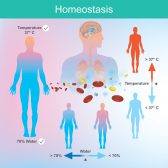Chlorosome is a photosynthetic micro-compartment that serves as a light-harvesting complex in sulfur bacteria and other anoxygenic phototrophic prokaryotes. One of its major features is its lack of protein matrix. Moreover, it is larger than the other antenna complexes. In green sulfur bacteria, their dimension ranges from 100 nm to 200 nm in length, 50 to 100 nm in diameter, and 15 to 30 nm in height.(1) This antenna complex in green sulfur bacteria is essential to them since they live in aquatic habitats with depths of 100 meters. With about 250,000 chlorophyll pigments, it improves photon capture at low-light habitats. Chlorosomes are one of the organellar-like compartments in prokaryotes. The others are carboxysomes and magnetosomes.
See also
- Cell
- Organelle
References
- Martinez-Planells, A., Arellano, J. B., Borrego, C. M., López-Iglesias, C., Gich, F., & Garcia-Gil, J. (2002). “Determination of the topography and biometry of chlorosomes by atomic force microscopy”. Photosynthesis Research. 71 (1–2): 83–90.
© Biology Online. Content provided and moderated by Biology Online Editors







